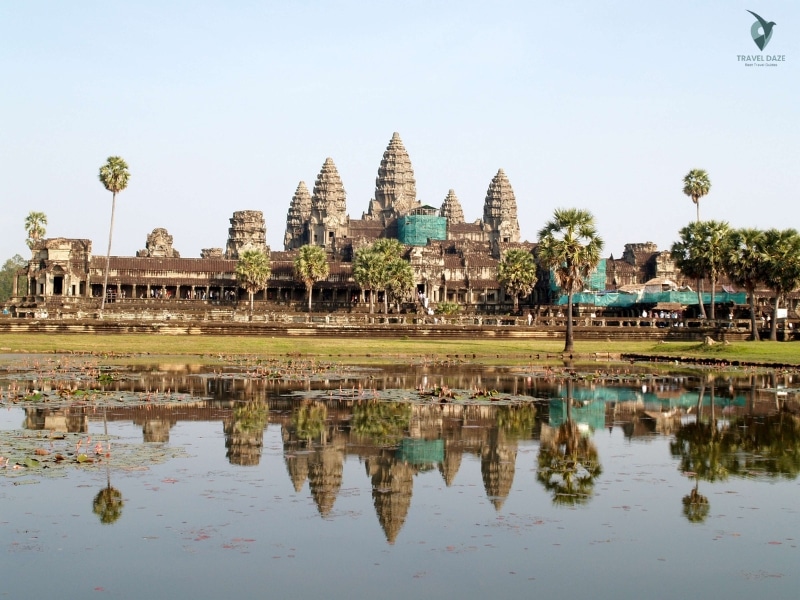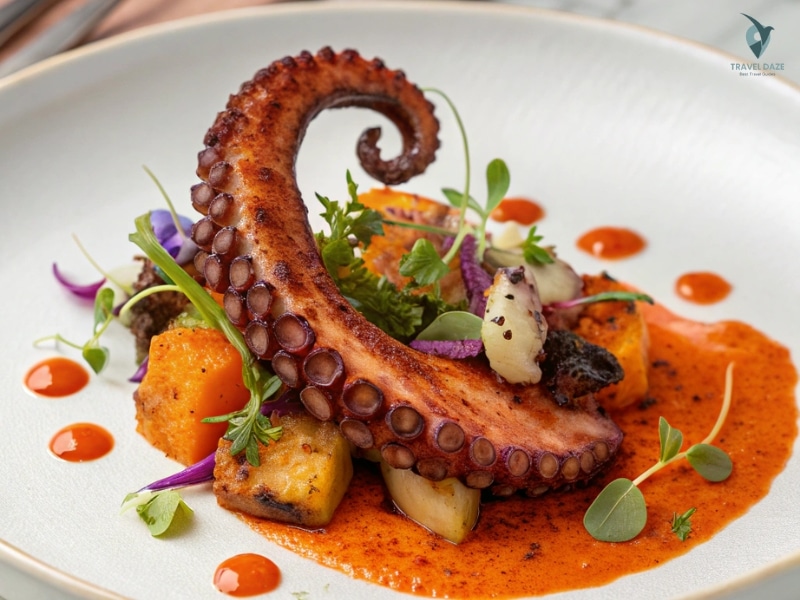Mark Twain once said, “Travel is fatal to prejudice, bigotry, and narrow-mindedness.” This is especially true when discovering the lively and varied region of Southeast Asia. This area has everything from busy cities to calm beaches, providing a memorable experience that is affordable.
Table of Contents
ToggleI discovered that private rooms can be as low as $10 to $20 per night, and tasty local meals usually cost about $3. Travelling between countries is easy and secure, with buses and flights linking vibrant cultural spots. As you explore old temples or enjoy street food, each day feels like a new adventure.
Choosing the right time for your trip is important. Going between November and February helps you stay away from the rainy season and smog. I suggest you spend at least three weeks to fully appreciate the beauty of the area. Every country has its own special appeal, so choose your path according to what you enjoy and how much time you have.
Main Points
- Private rooms and meals that are budget-friendly make it easy to explore the area without spending too much.
- Affordable and reliable transport links different places.
- Schedule your trip from November to February for the ideal weather.
- Take at least three weeks to really enjoy the area.
- If you have dietary restrictions, be careful with prawn paste and fish sauce in local dishes.
Southeast Asia is an ideal destination for budget travel.
Discovering this area of the world can be affordable. Street food here ranges from $1.50 to $5, and hostel dorms are available for $5 to $18 per night. These prices are very low when you look at Western standards. Local buses cost about $1 per hour, which makes it simple to travel between cities without spending a lot.

The transportation infrastructure is well-developed. Apps such as Grab make travelling in cities easy, and overnight buses link important places effectively. You can save on lodging by travelling at night and waking up somewhere new.
The cultural experiences here are very affordable as well. Getting into temples, markets, and UNESCO World Heritage sites usually costs less than $5. This lets you dive into the area’s rich history and traditions without spending too much money.
Good exchange rates for USD and EUR help your money stretch further. For instance, you can get a filling meal or a quick bus ride for just $1. If you want to make your trip longer, think about work exchange programmes such as Worldpackers or Workaway. These platforms allow you to exchange your skills for a place to stay and food, helping you save money.
Southeast Asia provides a special mix of low costs and vibrant culture. This region is perfect for budget travellers, whether you’re enjoying street food, visiting ancient temples, or travelling between countries.
Planning Your Trip: When to Go and How Much to Spend
Choosing the right time for your trip can greatly affect how enjoyable it is. The ideal time to explore most of the area is from November to February. This skips the rainy season and guarantees nice weather. If you’re going to central Vietnam, it’s best to wait until December for clearer skies.
March can be challenging in Thailand and Cambodia because of smog, so make sure to plan ahead. If you plan to visit in December or January, make sure to book your accommodations in advance. These months are the busiest time, and prices can rise fast.
As you plan your trip, think about the amount of time available to you. A 6-week trip across multiple countries lets you see more, while a 2-week stay in one country offers a chance to dive deeper into the culture. Each option has its advantages, so pick the one that suits your interests best.
I have a personal booking strategy: I always choose refundable reservations. This allows me to adapt if plans change. Try to set aside about $35 each day for your budget. This covers food, travel, and even a few tours.
Remember that prices can go up during peak season, especially in popular places. To save money, think about travelling right before or after the busiest months. This way, you can enjoy nice weather without the crowds.
- The best time for most of the region is from November to February.
- December is the best time to visit Central Vietnam.
- In March, Thailand and Cambodia experience smog.
- Make sure to book your accommodations for December and January in advance.
- Choose refundable reservations for more flexibility.
How to Find Cheap Flights to Southeast Asia
Choosing the right flight can really impact your trip. I start by using tools like Skyscanner or Kayak to check prices. These platforms help you find the best deals for your trip easily.
Flying into big cities like Bangkok, Ho Chi Minh City, or Hanoi can often help you save money. Additionally, making a reservation on a Tuesday or Wednesday can greatly reduce expenses. These days usually have lower flight prices.
AirAsia is a good choice for short trips in the region, with prices between $25 and $90. This allows for affordable travel to various countries in the area. I’ve discovered that making plans in advance is beneficial.
Here are a few more ways I’ve saved money on flights:
- Round-trip tickets usually cost less, but open-jaw flights can help you save time when visiting several places.
- Watch Google Flights for rare error fares, as they can offer great deals.
- Packing light with just a carry-on helps you avoid baggage fees and saves you money.
- Chase Sapphire Preferred: This card provides travel credits that can help reduce flight expenses.
- Flying through Dubai or Doha can often be a more affordable option for Middle Eastern routes.
These tips will help you discover budget-friendly flights and enjoy your trip to the fullest. Begin your search early and remain open to find the best offers.
Affordable Places to Stay
Looking for a place to stay can be easy and affordable. I’ve looked into different choices, from dorms to private rooms, and discovered that there’s something for everyone’s taste and budget. The area has many options, whether you want a lively social scene or a peaceful getaway.
Hostels: The Ideal Choice for Backpackers
Hostels are a great option for meeting other travellers and saving money. In Laos, I’ve found dorms for as low as $5 a night, but in Singapore, the prices can reach up to $60. Well-known places such as Vietnam’s “Vietnam Backpacker Hostels” and Thailand’s “Slumber Party” provide clean, safe, and friendly atmospheres.
Booking strategies are important as well. I’ve had good experiences with Agoda for last-minute deals, particularly in places like Chiang Mai, where private rooms are about $20. In popular tourist spots like Koh Phi Phi, prices can rise to $80 a night, so it’s a good idea to plan ahead.
Guesthouses: Affordable Comfort
If you want more privacy, guesthouses are a good option. I’ve found comfortable places with private bathrooms for less than $30 a night. During my time in Luang Prabang, I had a memorable homestay experience. I paid $15 for a room and had the chance to connect with a local family.
For extended stays, I prefer Airbnb. Monthly rentals usually offer discounts, which makes them a good option if you plan to stay in one location for an extended period. I’ve also used Trusted Housesitters, which allows you to stay for free in return for taking care of pets or the house.
Be careful: during events like the Full Moon Party, the prices for places to stay can go up a lot. If you plan to go, make sure to book early or think about staying in nearby towns to save some money.
- Look at different hostel networks to find the best experience.
- For last-minute deals, choose Agoda, and for longer stays, go with Airbnb.
- Consider staying in homestays for a special cultural experience.
- Watch out for higher prices during popular events.
Affordable Eating: Street Food and Local Restaurants
One of the best ways to enjoy the culture is by tasting its food. From hot woks to tasty curries, each bite shares a story. The street food here is both budget-friendly and an exciting experience for your taste buds. No matter if it’s a $1.50 banh mi in Vietnam or a $2 bowl of pho, the tastes are memorable.

Street Food: A Tasty Journey
I found that the most crowded stalls usually have the freshest food. In Hoi An, cao lau was my favourite dish, and in Chiang Mai, khao soi won me over. Cold beer for just $0.80? Absolutely, yes! Hawker centres are a treasure, providing meals for just $3 to $5 a day.
Vegetarians have many choices, but watch out for hidden fish sauce. Apps such as Happy Cow can assist you in locating vegetarian-friendly restaurants. Always check for busy stalls; they indicate good quality and safety.
Community Markets: Fresh and Budget-Friendly
Markets offer a wide variety of fresh fruits and vegetables, along with interesting items to discover. Morning markets are great for picking up fresh ingredients, and night markets are lively with energy and street food. Here, it’s common to negotiate prices, especially when buying in large quantities. Sometimes, a bit of negotiation can make a big difference.
I really enjoy the lively markets in Bangkok and the peaceful ones in Luang Prabang. These places provide a look at everyday life and an opportunity to meet local people.
- Enjoy local dishes such as cao lau and khao soi.
- Choose busy stalls to make sure the food is safe.
- Go to morning markets for fresh fruits and vegetables, and check out night markets for a fun and lively vibe.
- Negotiate kindly for large orders.
- Try the Happy Cow app to find vegetarian choices.
Travelling: Affordable Ways to Get Around
Getting around the area is simpler than you may expect. There are options for every need, from buses to ride-sharing apps. No matter if you’re going on a short trip or a longer journey, the systems available are made to be both efficient and affordable.
Public Transport: The Budget Traveler’s Option
Buses are a common way to travel around. In Cambodia, I looked at VIP buses and local ones and decided that the VIP option is worth the extra $5 for more comfort. Overnight buses, which cost between $10 and $20, are a smart option to save on lodging while travelling long distances.
Trains are a great choice. The Reunification Express in Vietnam provides sleeper berths priced between $21 and $36, offering a scenic and comfortable travel experience. Apps such as 12Go Asia make it easy to book tickets, even if you need them at the last minute.
Ride-sharing apps are easy to use and budget-friendly.
For short trips, ride-sharing apps such as Grab are very helpful. I’ve taken Grab bike taxis for $1 to $3 to get around city traffic quickly. It’s not only budget-friendly but also an enjoyable way to discover. Additionally, you can skip the trouble of haggling over prices with tuk-tuk drivers, who frequently earn commissions from attractions.
Here are a few suggestions to enhance your transportation experience:
- When comparing options, VIP buses are a good choice for long trips due to their added comfort and amenities.
- For your travel needs, use 12Go Asia to buy bus and train tickets.
- Be careful: Keep an eye out for scams related to motorbike rental insurance.
- Get discounts on airport transfers with Klook.
- Be careful of tuk-tuk drivers who offer expensive tours.
Using these strategies, you can get around easily and make the best use of your day. No matter if you take a bus or a bike taxi, the area’s transport options are made to help you get around affordably.
Tips for Travelling on a Budget in Southeast Asia
Enjoying your journey doesn’t need to be expensive. By using some clever strategies, you can make your money go further and have memorable experiences. There are always ways to save, whether you’re bargaining at markets or visiting free attractions.
Becoming Skilled at Negotiation
Learning how to negotiate prices is a valuable skill. In local markets, begin by setting the price at half of the original amount. The “50% first offer rule” usually results in a fair agreement. Here’s a helpful tip: Always smile and be polite; it really helps in creating a good connection with others.
It’s also important to haggle ethically. Be careful not to set prices too low, particularly with smaller vendors. Keep in mind that a little extra money can really help them, and it can still be a good deal for you.
Discovering Activities That Are Free or Affordable
There are plenty of free or low-cost activities available. In Bangkok, many temples welcome donations starting from just $1 to $2. Hanoi and Bangkok have free walking tours that let you discover the city’s history with the help of local guides.

National parks are a wonderful choice, with entry fees between $2.60 and $25. These parks provide beautiful views and an opportunity to enjoy nature. For a special experience, look into Couchsurfing events or Hostelworld meetups to meet locals and other travellers.
- Apply the “50% first offer rule” when negotiating.
- Always show respect and act ethically during negotiations.
- Explore free places such as the temples in Bangkok and the War Museum in Ho Chi Minh City.
- Participate in Couchsurfing events to enjoy real local experiences.
- Join Hostelworld meetups to meet travel companions.
Visa and Entry Rules
Knowing the visa requirements is important for an easy trip. Every country has its own regulations, so it’s essential to prepare in advance. The e-visa for Vietnam costs $25 and is valid for 30 days. Applying online is easy, but make sure to check your information to prevent any delays.
The eVisa in Cambodia costs $36 and can be applied for online. In Laos, you can get a visa on arrival for $50, but it may take some time. Thailand provides a 30-day visa exemption for numerous nationalities, making it an easy destination to visit.
Here are a few important tips to remember:
- Vietnam’s e-visa portal: Complete the form carefully and upload a clear photo of your passport. It typically takes 3 to 5 business days to process.
- When it comes to Thailand visa runs, be careful of companies that provide visa-run services. Some might charge too much or offer transport that isn’t dependable.
- If you plan to travel between countries, think about getting multi-entry visas to save both time and money.
- Your passport should be valid for at least six months before you enter.
- Keep informed: Visit iVisa.com for the most current visa information and requirements.
When you get ready ahead of time, you can skip the last-minute rush and concentrate on having fun during your adventure. Make sure to review the most recent rules, since policies may change unexpectedly.
Keeping Safe and Healthy While Saving Money
Being safe and healthy while discovering new places is important for a stress-free adventure. Some preparation can really help you feel secure, no matter where you are in the world. Here’s how to focus on your health without spending too much, covering everything from insurance to local healthcare.
Travel Insurance: Is It Valuable?
Having travel insurance is essential for feeling secure. I’ve used Heymondo, which is about $45 a month, and it has really helped me out. It’s a good idea to compare SafetyWing and World Nomads. SafetyWing provides excellent coverage for digital nomads, and World Nomads is perfect for adventurous travellers.
Each day matters when you’re travelling, and surprises can happen. Having insurance protects you, whether you miss a flight or have a minor injury. It’s a little investment that can help you avoid big fees later on.
Community Pharmacies: Cost-Effective Health Services
Local pharmacies are an affordable choice for small health issues. I went to a pharmacy in Chiang Mai to get antibiotics, and they were available without a prescription for only a few dollars. The staff knew a lot and assisted me in finding exactly what I needed.
The costs for vaccinations can increase quickly. A rabies series can cost more than $100. Consider going to travel clinics in Bangkok or Hanoi for trustworthy and budget-friendly services. Always check your medications carefully to avoid fake products, especially when it comes to preventing malaria.
- Look at Heymondo, SafetyWing, and World Nomads to find the best coverage.
- Check out nearby pharmacies for budget-friendly over-the-counter medicines.
- Plan for vaccination expenses, such as rabies, which can exceed $100.
- Visit reputable travel clinics in big cities for dependable healthcare.
- Be careful of fake medicines, especially for malaria.
Maximising Your Budget Travel Experience
Discovering this lively area provides countless chances to make lasting memories. A 6-week plan that includes all four countries lets you dive deep into the culture, history, and natural beauty. Cooking classes, costing between $15 and $30, are a great way to engage with local traditions and take a part of your journey home with you.
For a budget-friendly treat, think about a Ha Long Bay cruise for about $180. The views are truly amazing and worth the cost. Taking my time while travelling has become my favourite way to really enjoy the places I go to. Spending time to notice the details makes the experience deeper and more significant.
Reliable tour operators such as Buffalo Tours and Urban Adventures make exploring easy and enjoyable. If you want to discover hidden treasures, I suggest Ninh Binh instead of Halong Bay for its peaceful scenery and smaller crowds.
Here’s my final suggestion. Set aside some money for unexpected fun. Some moments, such as discovering a hidden temple or enjoying a meal with locals, are truly invaluable. Allow your journey to develop on its own and welcome each adventure that comes your way.
FAQ
Southeast Asia is a fantastic choice for travellers on a budget.
The area has affordable prices for food, places to stay, and getting around. Thailand, Vietnam, and Cambodia are very budget-friendly countries.
What is the best time to visit Southeast Asia?
The dry season, which typically runs from November to February, is perfect. It’s cooler, and you’ll stay dry, which makes exploring easier.
What are some ways to find affordable flights to Southeast Asia?
Try using flight comparison websites such as Skyscanner or Google Flights. Planning ahead and being open with your dates can help you save a lot.
What are the best affordable places to stay?
Hostels and guesthouses are budget-friendly options that often come with benefits such as free Wi-Fi and breakfast. I’ve discovered excellent offers on sites such as Hostelworld.
Is it safe to eat street food?
Yes, as long as it is freshly cooked and served hot. I have had wonderful meals at local stalls without any problems.
What is the most affordable way to travel?
Buses and trains are the best options for you. In cities, apps such as Grab are easy to use and affordable.
Is it a good idea to negotiate prices?
Definitely! Haggling is usual in markets and with tuk-tuk drivers. This skill can help you save money.
Do I need a visa to visit Southeast Asia?
Your nationality and the country you are visiting will determine this. Make sure to look at the entry requirements before you travel.
Do you really need travel insurance?
Yes, it is worth it. It takes care of surprise medical costs or trip cancellations, providing you with reassurance.
What are some ways to save on healthcare while travelling?
Local pharmacies are budget-friendly and usually stock what you need. They have been useful for small health issues.
What are some activities that are free or inexpensive?
Visiting temples, going for hikes, and checking out local markets are wonderful choices. Several cities offer free walking tours.





